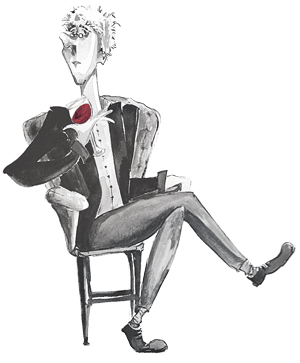Meet Nimrod Persiflage
Keeping score with my wine critic, fictional friend
Everyone could use an imaginary friend. My sister had one she called Johnny years ago, prompting Mother to consult experts. By the end of her run, our mother herself lived solely among imaginary friends. It is the way things go.

Never having such a companion then, I now, occasionally, summon one to help solve a problem of content or tone in my writing. Sometimes, the wraith joins me in staging a private “Punch and Judy” show. It’s the way things go.
Let me acquaint you with Nimrod Persiflage.
Known as “the man with the trillion dollar nose” and “The Bane of Burgundy,” he is the emperor of the world of wine. Like Caligula or Nero at the Coliseum, his thumb decides triumph or ignominy to the gladiators of the grape. One elite Brahmin monthly printed that Nimrod was the most influential critic of any field in the world. No spokesperson rushed to deny the claim on his behalf. Fame can prove tough.
Nimrod Persiflage needs no new emperor’s wardrobe because he, to an uncomfortable degree, is us.
A May 2015 item in the paper of record questioned how so much concentrated opinion power ruined the joys of wine for millions of consumers. Persiflage popularized the esteem of individual wines by number, like a score on a fourth-grade spelling quiz.
The numbers racket for wine consumers provides a good instance of unintended consequences. Persiflage started a numerical system in part to assess the qualities of wine. Instead, it dumbed down wine evaluations to a kind of “American Idol” audition. Wine seems to be made with the score in mind, and the resulting wine arrives as something reasonably made and with negligible individuality.
Worse, the Persiflage pronouncement pushed the prices of wine skyward.
Yes, I know it de rigueur to blame the hikes on Chinese demand, but that’s too pat. The price rose because watching the scoreboard turned the pleasures of wine drinking into a high-five, jockstrap locker room event. Competing in the marketplace has become a drive to win at any cost. The consumer pays for the wine speak that includes words such as “hand-crafted,” “artisanal,” and made by people of “passion” driven to “excellence.” Gimme a break.
Readers should consider whether their wine preferences have been shaped by encounters with wines of naturally similar character or determined by the numbers.
I compare this foolishness to the color-by-number pictures we made with the Venus Paradise Coloring Set, depositing colors onto predetermined plots. The outcome proved more puzzle-solving than art; that is why, despite the wine score hype, I prefer to trust my more cost-efficient palate and taste memory.
So, how did we arrive at this sorry pass?
As a “wine editor” for an out-of-state shelter magazine, I write as a reporter and reviewer — e.g., about what happened or what impression I took away with me. The role is about setting parameters — not parametrics — and providing standards intended to broaden appreciation for wine by expanding our knowledge of it. Criticism, on the other hand, is for those who would rather embark on a fault-finding scavenger hunt. The reach of the critic is as much informed by fear as admiration.
This distortion merits for me as much space in wine writing as a petri dish filled with Phylloxera bugs introduced to a spring planting. Airing concerns about the “critic” helps clarify what works in tasting many wines and writing about them. Issues become magnified because our wine scene is global, and much of that produced is good.
Northrop Frye published “Anatomy of Criticism” nearly 60 years ago. Decades later, I returned to it because, having finished a book about Oregon wine set to hit the boards next spring, I started to consider what I am doing when I write about wine. Am I a critic?
Rather, as writer, evaluation comes into play, but it remains a matter in which I don’t take the critical slice of cheese as the whole enchilada. Persiflage started out O.K., but his pronouncements became the message, and he became the point. This has little use, despite the automatic reply that we need the numbers. This is not merely nonsense; it is a dodge.
We need actual words, not adspeak or buzzwords or “look-how-clever” words. We require descriptive, non-technical words that convey an impression of savvy and skill applied.
Ken Friedenreich is writing a book on Oregon wine called “Decoding the Grape.” He contributes to various publications as a wine editor and columnist.











